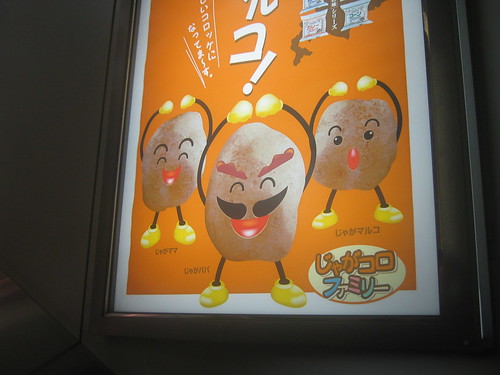
Boy, it’s gonna be tough to meaningfully fill these next few posts, since this day was mostly filled with travel (and no baseball) and the next is filled with baseball and not a whole lot of sightseeing, but I’ll do my best to make this as interesting as possible.
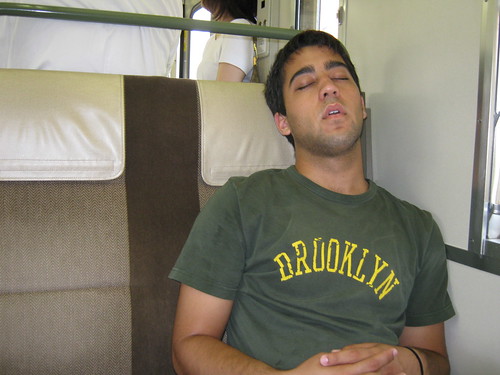
Since we were staying in Kyoto, our flight to Sapporo was based out of Kansai International Airport instead of Tokyo Narita. I’d flown through Kansai once before on my last trip to Japan, so it was nice to see the relatively uncrowded airport yet again. Our merry band of adventurers all queued up for the domestic flight and got to experience the differences between flying in the US and flying in Japan.
Foremost among those differences is the separate check-in and baggage handling sections. In the states, if you’re checking a bag, you can get your ticket at the baggage handling counter when you put the bag in. Out in Japan, you have to get your ticket first before queuing for the baggage check counters. I did not know this, but a combination of looking sad and confused and not understanding Japanese allowed me to just get my boarding pass and check in my bag as I was used to.
Speaking of checking in bags, unlike American airports, the baggage scanning is done directly in front of the passenger. Right before getting to the counter, the passenger puts his bag through a machine and security tapes the zippers down.
After that, you’re free to do what you want until the plane begins to board. The security lines don’t tend to be all that long (especially at Kansai), so I browsed some shops before heading to my gate. Not finding anything good or any food that especially called out to me, I headed to security.
Security has some cool Japanese quirks to it that make things go a bit smoother. Instead of showing your ticket to a security officer, you put the bitstream printed on the ticket up against the optical sensor, which prints out a receipt, for some reason. Your bags go through the machine, like normal, with the computers separate and, at least on domestic flights, you’re allowed to carry liquids on. If the bottle is unopened, there’s no need for concern. If it is, they have some simple tests (either through weight or a chemical test) to verify its potability and you’re allowed to take it into the terminal.
Another, HUGE, plus: you don’t have to take off your shoes for security. Hallelujah.
As a strange aside, one of my favorite things about Kansai International is that it has very spongy, springy people movers. Walking across them is tons of fun.
One uneventful, short flight later and I was landing in Sapporo. Looking out the window as we descended, I noticed that Hokkaido definitely looks “northern,” whatever that means. It also seemed way less populated than the Tokyo area, which makes tons of sense.
A train to Sapporo station later, we were boarding a taxi to get to our hotel. Sapporo looked no different from any other city I’d seen in Japan, except that its buildings weren’t quite so tall. It also looked more like a winter area, a qualification I make based on intangibles like vegetation and, possibly, the drab weather and cool breeze sweeping the city.
Along the (short) way to our hotel, Ken was reading a map to see where we were and Dan and I (that’s right, another Dan) were in the back seat chilling out. As Ken navigated the map, he noted “Aha, we’ll be stopping at the Eighth Ward.”
Dan quipped, “That’s great, because you don’t want to stray into Ninth Ward territory, those guys are rough.”
From then on, the Ninth Ward became a mythical, gang-filled section of Sapporo that Dan and I continuously referred to for the rest of the trip as a running gag. It’s really not that funny when you read it, but we were absolutely entertained by it until we went home.
I’m pretty sure that the whole numbered ward thing refers to districts or streets in Sapporo, but I find our definition funnier.
Our cab arrived at the Sapporo Garden Palace (by this point Dan and I were convinced that “Garden Palace” was Japanese for “hotel” because of how many we stayed at) and we were greeted by doors that heavily reminded me of that part in The Phantom Menace where Obi-Wan and Qui-Gon Jinn are fighting Darth Maul on Naboo.
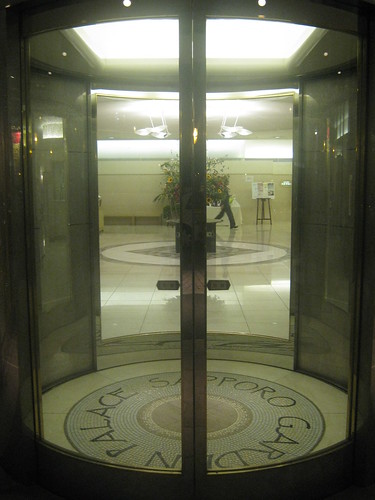
Upon checking in, I was given the largest key I’ve ever seen outside of a movie based in the Dark Ages. Seriously, this thing was huge.
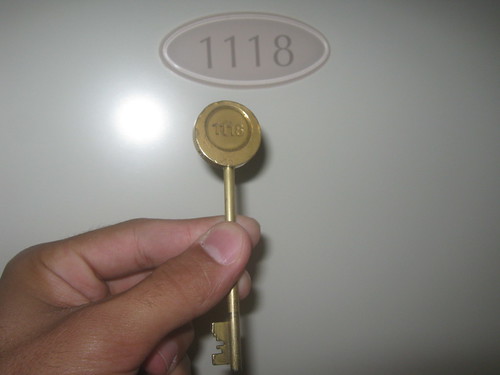
It was also used, as is the case in some Asian hotels, to save energy. Once I walked into my hotel room, there was a slot on the wall for me to put the key in. When the key was in place, a circuit was completed and the lights, air conditioning, and power outlets were all activated for use by the guest. It’s both brilliant and obnoxious, since I could not charge my various batteried gadgets while I was out of the room, but at least I wasn’t wasting electricity in some way.
A plan was hatched to grab dinner in Old Ramen Alley that night, so the six of us went out to explore the city in search of old ramen. Along the way, we passed one of the great landmarks of Sapporo, the Sapporo TV Tower. We marveled at how very…tiny it seemed. It was not a very imposing structure in the cityscape, since its height was dwarfed by several buildings in the downtown. Ken assured us that this wasn’t always the case, but it was rather anti-climactic.
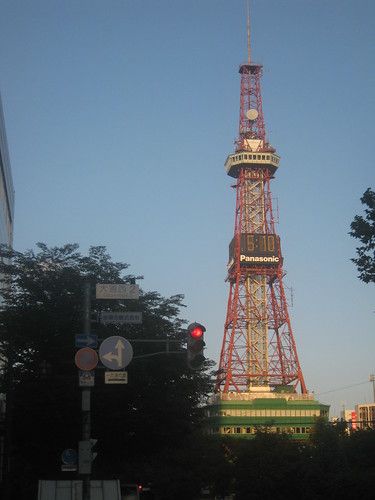
Eventually we came upon an entrance to the underground and what we thought would be the subway entrance. What we did find was even cooler.
Sapporo is a pretty northern city. To give you context, it’s on the same parallel as the border between North and South Dakota and it also intersects Oregon. They hold a snow festival here every year where they display ice sculptures. It can get pretty cold (Wikipedia says they get 248 inches of snow every year)
Sapporo’s answer, underground tunnels that traverse most of the city. You can get to most subway stations inside the much warmer, heated underground and many stores have connecting tunnels in their basements. It’s all very cool for getting around in the winter and I wish we had this up on campus when I used to be in school.
We eventually boarded the right subway and that was fairly uneventful aside from seeing a funny ad.
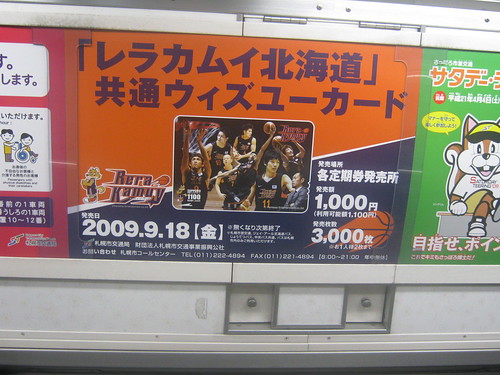
We got off the train, got back aboveground, and took a few seconds for me to shoot a picture of the reason I knew that Sapporo was a city before heading toward the Ramen district.
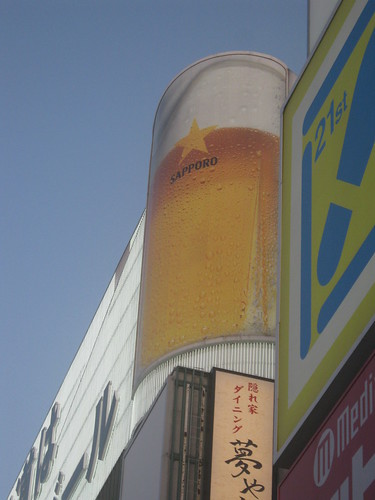
Old Ramen Alley is a pretty neat part of Sapporo. It’s a narrow…alley…filled with ramen shops…There’s also a New Ramen Alley somewhere in Sapporo, but we never got a chance to check and see if it had an ironic title.

You’ve gotta wonder how so many ramen shops could thrive in such a confined space, but the answer, according to Ken, is that each serves a slightly different variant. The one we were headed to had crab ramen available, which was pretty exciting to me.
The shop was a pretty tiny place with room for about, at the most, 15 people. Since we were the only customers there when we got there, we spread out in the restaurant.
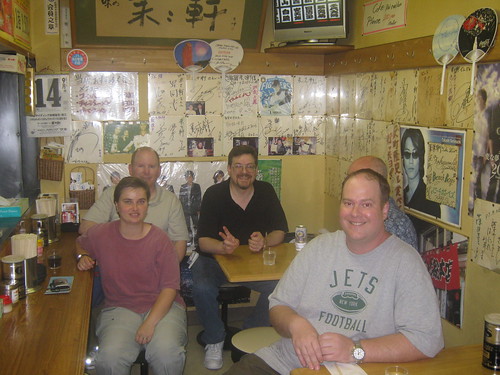
There was no doubt on my mind what I wanted, but we had to wait a bit before the crab ramen was done. We entertained ourselves by inventing commentary for the sumo match up on the tv.

The crab ramen came out.
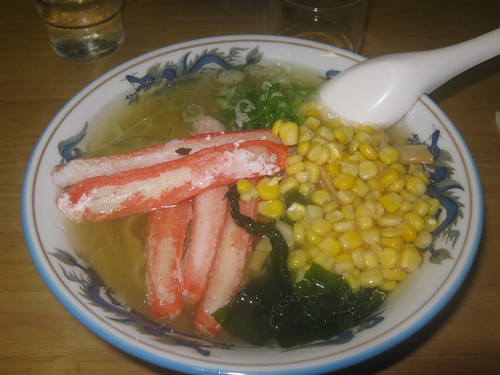
You can bet that I loved every bite!

It was perfectly cooked crab with a full, tasty broth enhanced with corn and other vegetables. Up to that point, I’d yet to have ramen that convinced me it was worth gushing over. This pushed me way over the edge.
Not much else happened that night. Dan and I wandered around Sapporo for a bit and checked out a Yodobashi Camera before eventually walking back to the hotel from Sapporo Station and confirming that a taxi was absolutely unnecessary for getting to the station. There was baseball tomorrow and we were excited for it!
One last thing worth mentioning. On our way to the ramen place, we came across this dude driving down the street and hollering at some girl.
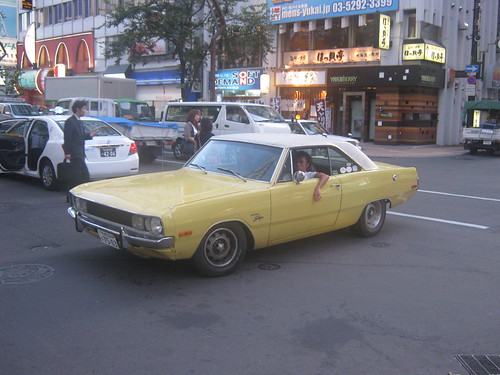
I was shocked to not only see an American car in Japan, but one that was so old and with the steering wheel on the American side. All I’ve gotta say is that this guy’s got cool taste in cars.
Leave a Reply